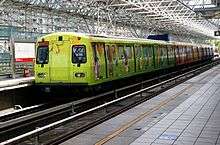Taipei Metro
Taipei Mass Rapid Transit (MRT),[3] branded as Taipei Metro,[upper-roman 1][4] is a metro system serving Taipei and New Taipei, Taiwan, operated by government owned Taipei Rapid Transit Corporation, which also operates Maokong Gondola.
.svg.png) | |||
A C381 stock near Beitou | |||
| Overview | |||
|---|---|---|---|
| Native name | 臺北捷運[upper-roman 1] | ||
| Owner | Taipei City Government | ||
| Locale | Taipei and New Taipei, Taiwan | ||
| Transit type | Rapid transit | ||
| Number of lines | 6 [lower-alpha 1][1] | ||
| Number of stations | 131[lower-alpha 2] | ||
| Annual ridership | 789.59 million (2019)[2] | ||
| Chief executive | BC Yen | ||
| Headquarters | 7 Lane 48 Sec 2 Zhongshan N Rd, Zhongshan District, Taipei | ||
| Website | english | ||
| Operation | |||
| Began operation | 1996-03-28 | ||
| Operator(s) | Taipei Rapid Transit Corporation | ||
| Character | Grade-separated | ||
| Number of vehicles | 217.5 trains[lower-alpha 3] | ||
| Train length | 6 carriages[lower-alpha 4] | ||
| Headway | 5 min 28 s[lower-alpha 5] | ||
| Technical | |||
| System length | 152.9 km (95.0 mi)[1] | ||
| No. of tracks | 2 | ||
| Track gauge | 1,435 mm (4 ft 8 1⁄2 in) standard gauge[lower-alpha 6] | ||
| Minimum radius of curvature | 200 metres (656 ft)[lower-alpha 7] | ||
| Electrification | 750 V DC third rail | ||
| Average speed | 31.50 kilometres per hour (20 mph)[lower-alpha 8] | ||
| Top speed | 90 kilometres per hour (56 mph)[lower-alpha 9] | ||
| |||
| Taipei Metro | |||||||||||||||||||||
|---|---|---|---|---|---|---|---|---|---|---|---|---|---|---|---|---|---|---|---|---|---|
| Traditional Chinese | 臺北捷運 | ||||||||||||||||||||
| Simplified Chinese | 台北捷运 | ||||||||||||||||||||
| |||||||||||||||||||||
| Taipei Rapid Transit System | |||||||||||||||||||||
| Traditional Chinese | 臺北大眾捷運系統 | ||||||||||||||||||||
| Simplified Chinese | 台北大众捷运系统 | ||||||||||||||||||||
| |||||||||||||||||||||
Taipei Metro was the first metro system in Taiwan.[5] The initial network was approved for construction in 1986 and work started two years later.[6] The first line opened in 1996 and by 2000, 62 stations were in service on three main lines.[7] Over the next nine years the number of passengers had increased by 70%. Since 2008, the network has expanded to 131 stations and the passenger count has grown by another 66%.
The system has often been praised for its safety, reliability and quality.[5][8][9] It has become effective in relieving traffic congestion in Taipei, with over two million trips made daily.[10] The system has also proven effective as a catalyst for urban renewal.
History
Proposal and construction

The idea of constructing the Taipei Metro was first put forth at a press conference on 28 June 1968, where the Minister of Transportation and Communications Sun Yun-suan announced his ministry's plans to begin researching the possibility of constructing a rapid transit network in the Taipei metropolitan area; however, the plan was shelved due to fiscal concerns and the belief that such a system was not urgently needed at the time. With the increase of traffic congestion accompanying economic growth in the 1970s, the need for a rapid transit system became more pressing.[11] In February 1977, the Institute of Transportation (IOT) of the Ministry of Transportation and Communications (MOTC) released a preliminary rapid transport system report, with the designs of five lines, including U1, U2, U3, S1, and S2, to form a rough sketch of the planned corridors, resulting in the first rapid transit system plan for Taipei.[12]
In 1981, the IOT invited British Mass Transit Consultants (BMTC) and China Engineering Consultants, Inc. to form a team and provide in-depth research on the preliminary report.[12] In 1982, the Taipei City Government commissioned National Chiao Tung University to do a research and feasibility study on medium-capacity rapid transit systems. In January 1984, the university proposed an initial design for a medium-capacity rapid transit system in Taipei City, including plans for Wenhu line and Tamsui–Xinyi line of the medium-capacity metro system.[12] On March 1, 1985, the Executive Yuan Council for Economic Planning and Development (CEPD) signed a treaty with the Taipei Transit Council (TTC), composed of three American consultant firms, to do overall research on a rapid transit system in metropolitan Taipei. Apart from adjustments made to the initial proposal, Wenhu line of the medium-capacity metro system was also included into the network. In 1986, the initial network design of the Taipei Metro by the CEPD was passed by the Executive Yuan, although the network corridors were not yet set.[6] A budget of NT$441.7 billion was allocated for the project.[13]
On 27 June 1986, the Preparatory Office of Rapid Transit Systems was created,[14] which on 23 February 1987 was formally established as the Department of Rapid Transit Systems (DORTS) for the task of handling, planning, design, and construction of the system.[13] Apart from preparing for the construction of the metro system, DORTS also made small changes to the metro corridor. The 6 lines proposed on the initial network were:[12] Tamsui line and Xindian line (Lines U1 and U2), Zhonghe Line (Line U3), Nangang Line and Banqiao Line (Line S1), and Muzha (now Wenhu) line (Wenhu line medium-capacity), totaling 79 stations and 76.8 km (47.7 mi) route length,[13] including 34.4 km (21.4 mi) of elevated rail, 9.5 km (5.9 mi) at ground level, and 44.2 km (27.5 mi) underground.[14] The Neihu Line corridor was approved later in 1990. On 27 June 1994, the Taipei Rapid Transit Corporation (TRTC) was formed to oversee the operation of the Taipei Metro system.
The Executive Yuan approved the initial network plan for the system on 27 May 1986.[6] Ground was broken and construction began on 15 December 1988.[6] The growing traffic problems of the time, compounded by road closures due to TRTS construction led to what became popularly known as the "dark age of Taipei traffic". The TRTS was the center of political controversy during its construction and shortly after the opening of its first line in 1996 due to incidents such as computer malfunction during a thunderstorm, alleged structural problems in some elevated segments, budget overruns, and fare prices.
Initial network
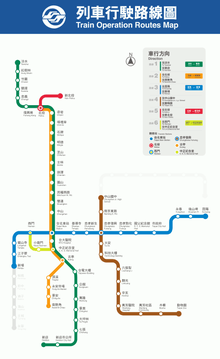
The system opened on 28 March 1996, with the 10.5 km (6.5 mi) elevated Wenhu line, a driverless, medium-capacity line[6] with twelve stations running from Zhongshan Junior High School to Taipei Zoo. The first high-capacity line, the Tamsui–Xinyi line, began service on 28 March 1997, running from Tamsui to Zhongshan, then extended to Taipei Main Station at the end of the year. On 23 December 1998, the system passed the milestone of 100 million passengers.[15]
On 24 December 1999, a section of the Bannan line was opened between Longshan Temple and Taipei City Hall.[6] This section became the first east-west line running through the city, connecting the two previously completed north-south lines. On 31 May 2006, the second stage of the Banqiao–Nangang section and the Tucheng section began operation.[6] The service was then named Bannan after the districts that it connects (Banqiao and Nangang).
On 4 July 2007, the Maokong Gondola, a new aerial lift/cable-car system, was opened to the public. The system connects the Taipei Zoo, Zhinan Temple, and Maokong. Service was suspended on 1 October 2008 due to erosion from mudslides under a support pillar following Typhoon Jangmi.[16] The gondola officially resumed service as of 31 March 2010, after relocation of the pillar and passing safety inspections.[17]
2009–2014 expansions
On 4 July 2009, with the opening of the Neihu section of Wenhu line, the last of the six core sections was completed. Due to controversy on whether to construct a medium-capacity or high-capacity line, construction of the line did not begin until 2002.[18]
Zhonghe–Xinlu line was extended from Guting to Luzhou and Huilong in 2012. The Xinyi section of Tamsui–Xinyi line and Songshan section of Songshan–Xindian line were opened on 24 November 2013 and 15 November 2014 respectively.
Prior to 2014, only physical lines had official names; services did not. In 2008, the Tamsui–Xindian–Nanshijiao and Xiaonanmen services were referred to by termini[19][20] while Bannan and Wenhu services were referred to by the physical lines on which they operated.[21][22]
Following the completion of the core sections of the system in 2014, the naming scheme for services was set and 'lines' started to referred to services. Between 2014 and 2016, lines were given alternative number names based on the order of the dates the lines first opened. Brown, Red, Green, Orange and Blue lines were named lines 1 to 5 respectively. The planned Circular, Wanda–Shulin and Minsheng–Xizhi lines were to be lines 6 to 8 respectively. In 2016, the number names were replaced by colour names. Today, Chinese announcements use full names while English announcements use colour names.
Circular line
The Circular line is sixth main line, opened on 31 January 2020.[23] Stage I construction consists of section running from New Taipei Industrial Park on Taoyuan Airport MRT to Dapinglin on Songshan–Xindian line and is about 15.4 km (9.6 mi) long with 14 stations.[1] Electromechanical equipment for the line is supplied by Hitachi Rail STS, including driverless technology and CBTC Radio signalling.[24] In February 2020, free rides were offered to passengers in order to raise awareness and test the route's popularity.[25][26]
Timeline of services
Lines


The system is designed based on spoke-hub distribution paradigm, with most rail lines running radially outward from central Taipei. The MRT system operates daily from 06:00 to 00:00 the following day[27] (the last trains finish their runs by 01:00), with extended services during special events (such as New Year festivities).[28] Trains operate at intervals of 1:30 to 15 minutes depending on the line and time of day.[27][29] Smoking is forbidden in the entire metro system, while eating, drinking, and chewing gum and betel nuts are forbidden within the paid area.[30]
Stations become extremely crowded during rush hours, especially at transfer stations such as Taipei Main Station, Zhongxiao Fuxing, and Minquan West Road. Automated station announcements are recorded in Mandarin, English, Hokkien, and Hakka, with Japanese at busy stations.[31]
| Icon | Full name | Announced name | Services | Peak headway (mins) | Off-peak headway, typical | Stations |
|---|---|---|---|---|---|---|
| Wenhu line | Brown line | Nangang Exhib Center–Taipei Zoo | 2–4 | 4–10 | 24 | |
| Tamsui–Xinyi line | Red line | Tamsui–Xiangshan (full service) | 6 | 8–10 | 28 | |
| Beitou–Daan (short turn service) | 3[lower-alpha 10] | 4–5[lower-alpha 10] | ||||
| Beitou–Xinbeitou (Xinbeitou branch) | 7–8 | 10 | ||||
| Songshan–Xindian line | Green line | Songshan–Xindian (full service) | 4–6 | 6–8 | 20 | |
| Songshan–Taipower Building (short turn service) | 3[lower-alpha 10] | 4–6[lower-alpha 10] | ||||
| Qizhang–Xiaobitan (Xiaobitan branch) | 12–20 | 12–20 | ||||
| Zhonghe–Xinlu line | Orange line | Luzhou–Nanshijiao (Luzhou branch) | 6[lower-alpha 11] | 8–10[lower-alpha 12] | 26 | |
| Huilong–Nanshijiao (Xinzhuang branch) | 6[lower-alpha 11] | 8–10[lower-alpha 12] | ||||
| Bannan line | Blue line | Dingpu–Nangang Exhib Center (full service) | 6 | 8–10 | 23 | |
| Far Eastern Hospital–Kunyang (short turn service) | 3 | 4–5 | ||||
| Circular line | Yellow line | New Taipei Industrial Park–Dapinglin | 4–7 | 5–10 | 14 |
Fares and tickets

Fares range between NT$20–65 per trip as of 2018. RFID single journey tokens and rechargeable IC cards are used to collect fares for day-to-day use. A 20% off discount was given to all IC card users. However, the discount for IC card users will be cancelled in February 2020. The discount program will switch to an intensity-based scheme. The more times passengers take the metro, the higher the level of discount they could receive. For example, 10% discount is given for 11–20 rides; 20% discount is provided for 31–40 journeys; the highest discount is 30% off for more than 50 rides.[32] Those with welfare cards issued by local governments could receive 60% off per ride.[33] Children aged 6 or over pay adult fares. Other ticket types include passes, joint tickets with other services and tickets for groups and cyclists.[34]
Infrastructure


The Taipei Metro provides an obstacle-free environment within the entire system; all stations and trains are handicap accessible. Features include:[35][36][37] handicap-capable restrooms, ramps and elevators for wheelchairs and strollers, tactile guide paths, extra-wide faregates, and trains with a designated wheelchair area.[38]
Beginning in September 2003, the English station names for Taipei Metro stations were converted to use Hanyu pinyin before the end of December, with brackets for Tongyong Pinyin names for signs shown at the station entrances and exits.[39] However, after the conversion, many stations were reported to have multiple conflicting English station names caused by inconsistent conversions, even for stations built after enactment of the new naming policy.[40] The information brochures (臺北市大眾捷運系統捷運站轉乘公車資訊手冊) printed in September 2004 still used Wade–Giles romanizations.[41]
To accommodate increasing passenger numbers, all metro stations have replaced turnstiles with speedgates since 2007, and single journey magnetic cards have been replaced by RFID tokens.[42] TRTS provides free mobile phone connections in all stations, trains, and tunnels and also provides WiFi WLAN connections at several station hotspots.[43] The world's first WiMAX-service metro trains were introduced on the Wenhu line in 2007, allowing passengers to access the internet and watch live broadcasts.[44] Several stations are also equipped with mobile charging stations.[45]
Platforms
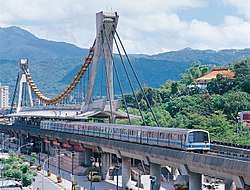
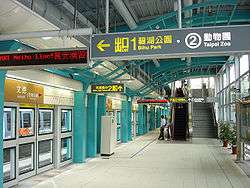

Most stations on high-capacity lines have island platform configurations while a few have side platform configurations, and vice versa for medium-capacity lines (a few stations have island platform configurations but the majority of medium-capacity stations have side platform configurations). All high-capacity metro stations have a 150 m (490 ft) long platform to accommodate all six train cars on a typical metro train (with the exception of Xiaobitan). The width of the platform and concourse depends on the volume of transit; the largest stations include Taipei Main Station, Zhongxiao Fuxing, and Taipei City Hall. Some other transfer stations, including CKS Memorial Hall, Guting, and Songjiang Nanjing, also have wide platforms.
Each station is equipped with LED displays and LCD TVs both in the concourse and on the platforms which display the time of arrival of the next train. At all underground stations, red lights along the platform edge (or on automatic platform gates at stations where they are installed) flash one minute prior to train arrival to alert passengers. As of September 2018, all stations have automatic platform gates.[46]
All the stations on the Wenhu line and Zhonghe–Xinlu line, as well as at Taipei Nangang Exhibition Center, are equipped with platform screen doors. High-traffic stations, including Taipei Main Station, Zhongxiao Fuxing, and Taipei City Hall,[47][48] have platform gates to prevent passengers and other objects from falling onto the rails.[49] All lines and extensions currently under construction will be equipped with platform screen doors. A Track Intrusion Detection System has also been installed to improve passenger safety at stations without platform doors.[49] The system uses infrared and radio detectors to monitor unusual movement in the track area.[50]
Signalling
.jpg)
When the Muzha Line first opened in 1996, the line was initially equipped with automatic train operation (ATO) and automatic train control (ATC), which in turn comprised automatic train protection (ATP) and automatic train supervision (ATS); in particular the ATP relied on transmission coils and wayside control units whereas the ATO relied on dwell operation control units. The transmission coils are controlled by the Control Centre to ensure safety of the line and were positioned on the guideway. Among such coils included the PD loop, safety frequency loop, stopping program loop, vehicle station link and station vehicle link; these loops were cross-arranged to produce electromagnetic induction with the interval between two cross points being 0.3 seconds to both monitor the train and control its speed.[51] However this fixed-block ATC system used on the Muzha Line was plagued with problems in its early years of operation and was replaced with the new moving-block Cityflo 650 CBTC that was supplied by Bombardier Transportation of Canada for the Neihu Line.[52]
On the other hand, the heavy-capacity lines use an ATC system by Alstom whose components include vital processor interlocking (VPI), AF track circuits, wayside ATP (Automatic Train Protection) modules, Model 5 switch machines, and Microcabmatic for carborne train control.[53] Heavy-capacity trains are capable of the following modes:[54]
- Fully automatic mode: Except for the driver closing the door, all other driving instructions are executed by the computer.
- CM mode (Code Mode): The driver uses the master controller to drive the train according to the ATP speed code.
- RM mode (Restriction Mode): The driver uses the master controller to drive the train at a speed limit of 25 km/h. It has door protection.
- YM mode (Yard Mode):. The driver uses the master controller to drive the train at a speed limit of 25 km/h, but it does not have door protection.
- Car wash/connection mode: The driver uses the master controller to drive the train at a speed limit of no more than 5 km/h. At this time, the car wash/connection warning light above the middle of the head end face will maintain a blinking state to alert any wayside personnel nearby.
- Reverse mode: The driver uses the master controller and reverses the train up to 5 km/h.
The Circular Line uses CBTC Radio signalling from Ansaldo STS.[55]
Public art
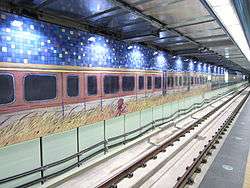
In the initial network, important stations such as transfer stations, terminal stations, and stations with heavy passenger flow were chosen for the installation of public art. The principles behind the locations of public art were visual focus and non-interference with passenger circulation and construction schedules. The artworks included murals, children's mosaic collages, sculptures, hung forms, spatial art, interactive art, and window displays. The selection methods included open competitions, invitational competitions, direct assignments, and cooperation with children.
Stations with public art displays include: Shuanglian, NTU Hospital, Chiang Kai-shek Memorial Hall, Guting, Gongguan, Xindian, Xiaobitan, Dingxi, Nanshijiao, Taipei City Hall, Kunyang, Nangang, Haishan, and Tucheng. Stations with art galleries include Zhongshan, Chiang Kai-shek Memorial Hall, Zhongxiao Fuxing, and Taipei Main Station.
The promotion for artwork continues today – the Department of Rapid Transit held a bid on providing public large scale artwork for the interiors of Sanchong. The bid is placed at over NT$9 million.[56]
Other facilities
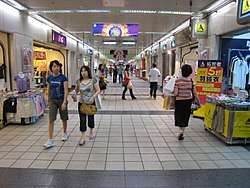
In addition to the rapid transit system itself, Taipei Metro operates several public facilities such as underground shopping malls, parks, and public squares in and around stations,[57] including:
- Zhongshan Metro Mall: Shuanglian – Zhongshan – Taipei Main Station (815 m, 81 shops).[49]
- Taipei main station underground mall: on floor B1 of the station.
- Taipei New World Shopping Center: Between the metro and TRA sections of Taipei Station.
- Station front metro mall: West of Taipei main station, beneath Zhongxiao W Road.
- Taipei City Mall: Northwest of Taipei main station, beneath Zhengzhou Rd and Civic Blvd.
- East Metro Mall: Between Zhongxiao Fuxing and Zhongxiao Dunhua (825 m, 35 shops).[49][58]
- Ximen Underground Mall: north of Ximen (currently used as an office building and library).
- Longshan Temple Underground Mall: Longshan Temple north and south sides.
- Global Mall: Banqiao floors B1 to 2F.
As of 2008 there are 102 shops within the stations themselves.[49]
Transit

Transfers to city bus stations are available at all metro stations. In 2009, transfer volume between the metro and bus systems reached 444,100 transfers per day (counting only EasyCard users).[59] Connections to Taiwan Railway Administration and Taiwan High Speed Rail trains are available at Taipei Main Station, Banqiao and Nangang. Connections to Taipei Bus Station and Taipei City Hall Bus Station are available at Taipei Main Station and Taipei City Hall stations, respectively. The Maokong Gondola is accessible from Taipei Zoo.
Taipei Songshan Airport is served by the Songshan Airport station.[60] A metro system to connect Taipei to Taoyuan International Airport is also available since February 2017.
Rolling stock
Rolling stocks on the Taipei Metro are multiple unit rolling stocks, using a third rail to provide electricity (750 volts DC) for propulsion. Each train is equipped with automatic train operation (ATO) for a partial or complete automatic train piloting and driverless functions.
Medium-capacity trains
The medium-capacity trains of Wenhu line are 6 ft 2 in (1,880 mm) gauge rubber-tired trains with no onboard train operators but are operated remotely by the medium-capacity system operation control center. It uses a fixed-block Automatic Train Control (ATC) system. Each train consists of two 2-car Electric Multiple Unit (EMU) sets, with a total of 4 cars.[1] Each car is a closed end car where passengers cannot walk between cars unless the train stops and the doors are open.
The Wenhu line was initially operated with VAL 256 trains cars, where two VAL 256 cars in the same set would share the same road number. As a result of this numbering scheme, the 102 cars of the VAL fleet have car numbers from 1 to 51. On June 2003, Bombardier was awarded a contract to supply the Wenhu line with 202 Innovia 256 train cars , to install the communications-based CITYFLO 650 moving-block ATC system to replace the fixed-block ATC system and also to retrofit the existing 102 VAL 256 cars with the CITYFLO 650 ATC system. Integration of Bombardier's trains with the existing Wenhu line proved to be difficult in the beginning, with multiple system malfunctions and failures during the first three months of operation.[61] Retrofitting older trains also took longer than expected, as the older trains must undergo several hours of reliability tests during non-service hours. The VAL 256 trains resumed operations in December 2010.
The Hitachi Rail Italy Driverless Metro is used on the Circular line, which entered service in the January 2020 with the opening of the first section of the Circular line. Each train consists of a 4-car EMU set and with open-gangway connection between cars. The train runs on 4 ft 8 1⁄2 in (1,435 mm) gauge without onboard operators.[24]
Heavy-capacity trains
The heavy-capacity trains have steel wheels and are operated by an on-board train operator. The trains are computer-controlled. The operator, who is both driver and conductor, is responsible for opening and closing the doors and making announcements. The ATC provides the functions of ATP, ATO and ATS[62] and controls all train movements, including braking, acceleration and speed control, but can be manually overridden by the operator in the case of an emergency. Newer trains also use a Train Supervision Information System (TSIS) supplied by Mitsubishi Electric that allows the operator to monitor the conditions of the train and identify any faults.[54]
Each train consists of two 3-car Electric Multiple Unit (EMU) sets with a total of 6 cars.[1] Each 3-car EMU set is permanently coupled as DM-T-M, where DM is the motor car with full-width cab, T is a trailer car and M is the motor car without cab. Each motor car has two AC traction motors. The configuration of a 6-car train is DM-T-M-M-T-DM, not interchanged with other car types. Like many contemporary metro rolling stock designs such as the Bombardier Movia, each train features open gangways, allowing passengers to move freely between cars.
In Set XXX, the road number of a DM car is 1XXX, the road number of a T car is 2XXX and the road number of an M car is 3XXX. The table below shows the set numbers of the heavy-capacity car types, which include Types C301, C321, C341, C371, and C381. For example, if the car numbers of a C301 train is 1001-2001-3001-3002-2002-1002, two C301 sets 001 and 002 form this train.
A single set cannot be in revenue service except C371 single sets 397–399, where their M car is exactly a DM car despite its car number being 3XXX. These single sets run exclusively on Xinbeitou branch and Xiaobitan branch.[63] Before the C371 single sets were in revenue service on 22 July 2006, the M cars of C301 sets 013-014 were converted to temporary cab cars to run the Xinbeitou branch.
In 2010, the new C381 was built for Taipei Metro to cope with increasing passenger ridership and the expansion of its network route. Upon entering service on 7 October 2012, three C381 trainsets are servicing the Beitou – Taipower Building segment of the Tamsui and Xindian Lines, with the remaining fleet being put into service on 20 October 2012. These trains provided much-needed capacity increase when the Xinyi and Songshan extensions opened in late 2013. After November 2014, the C381 trains are serving both Tamsui–Xinyi line and Songshan–Xindian line. Whereas the earlier heavy capacity train types have largely retained the same design, the C381 sets are more distinctive with double blue stripes and the re-positioning of the logo from the driver's door to well below of passenger's windows, right on the stripe; as well as the more "sleeker" cab and the new advertising screens (as seen in newer Japanese commuter trains such as the E233 series) to improve energy efficiency, although it retains the same propulsion as the C371s.
Fleet roster
| Car Type |
Photo | Year Built |
Builder | Car Length/ Width/ Height |
Seating capacity per car |
Total capacity Per car |
Max. speed |
Fleet total |
Car set numbers |
Assigned Services |
Depot Assignment |
Notes |
|---|---|---|---|---|---|---|---|---|---|---|---|---|
| VAL256 | 1990~1993 | Matra and GEC-Alstom | 13.78 m/ 2.56 m/ 3.53 m |
24 | 114 | 80 km/h |
102 | 01~51 |
|
| ||
| Innovia 256 | 2006~2007 | Bombardier | 13.78 m/ 2.54 m/ 3.53 m |
20 | 142 | 80 km/h |
202 | 101~201 |
|
| ||
| Hitachi Rail Italy Driverless Metro |  |
2016 | Hitachi Rail Italy | 17.0 m/ 2.65 m/ 3.6 m |
24 | 650 | 80 km/h |
68 | 101-117 |
|
| |
| C301 | 1992~1994 | Kawasaki and URC | 23.5 m/ 3.2 m/ 3.6 m |
60 | 368 | 90 km/h |
132 | 001-044 |
|
| ||
| C321 | 1998~1999 | Siemens | 23.5 m/ 3.2 m/ 3.6 m |
60 | 368 | 90 km/h |
216 | 101–116 119-172 175-176[64] |
|
| ||
| C341 | 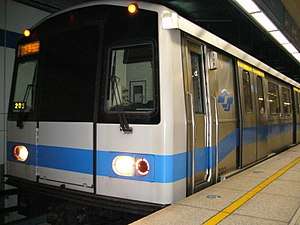 |
2003 | Siemens | 23.5 m/ 3.2 m/ 3.6 m |
60 | 368 | 90 km/h |
36 | 201–212 |
|
| |
| C371 | 
|
2005~2009 | Kawasaki and TRSC | 23.5 m/ 3.2 m/ 3.6 m |
60 | 368 | 90 km/h |
321 | 301–338 (1st batch) 401–466 (2nd batch) 397~399 (for branch lines only) |
|
| |
| C381 | .jpg) |
2010~2013 | Kawasaki and TRSC | 23.5 m/ 3.2 m/ 3.6 m |
60 | 368 | 90 km/h |
144 | 501–548 | [Note 1] |
|
|
Engineering trains
Taipei Metro also uses a fleet of specialised trains for maintenance of way purposes:[65]
| Car Type | Purpose | Builder | Max. speed | Length | Usage |
|---|---|---|---|---|---|
| Barclay locomotive | Traction for maintenance rolling stock | Hunslet-Barclay | 35 km/h | 13.5 m | Heavy-capacity |
| Tamping machine | Track ballast tamping | Plasser & Theurer | 0.25 km/h | 29.2 m | |
| Railgrinder | Restore the profile and remove irregularities from worn tracks | Speno | 2~7 km/h | 33 m | |
| Rail inspection vehicle | Measure and record rail track-related data | Plasser & Theurer | 30 km/h | 12.5 m | |
| Ultrasonic flaw detection vehicle | Detects internal cracks within rail tracks using ultrasound | Speno | 25 km/h | 8.4 m | |
| High pressure cleaning car | Cleaning of rail tracks and third rail | China Steel Corporation | 2~7 km/h | 52 m (combined length) | |
| Water storage and power car | Provides water source and propulsion for high pressure cleaning car | ||||
| Vacuum suction vehicle | Remove tunnel sludge | China Steel Corporation | N/A | 19 m | |
| Flash welding vehicle | Rail welding | Plasser & Theurer | N/A | 16.24 m | |
| Rail crane wagon | Lifting heavy spare parts | China Steel Corporation | 45 km/h | 11.2/11.4/16.4/18.7 m | |
| Flat wagon | Carry spare parts | N/A | N/A | 18.7 m | |
| Open wagon | Carry ballast | China Steel Corporation | N/A | 19.8 m | |
| Water tanker | Store water used for cleaning purposes | N/A | 2~7 km/h | N/A | |
| Maintenance locomotive | Maintenance of way | Nicolas | N/A | N/A | Medium capacity |
Depots
The system currently has 9 depots, with more under construction,[66][67] including the Xinzhuang Depot, expected to be completed in 2022.[68]
| Depot Name | Year Opened | Location | Rolling Stock Housed | Line(s) Served |
|---|---|---|---|---|
| Muzha | 1996 | Wenshan, northeast of Taipei Zoo | VAL256 | |
| Beitou | 1997 | Beitou, southwest of Fuxinggang | Kawasaki C301, C371 (single), C381 | |
| Zhonghe | 1998 | Zhonghe, east of Nanshijiao | Kawasaki C371 | |
| Xindian | 1999 | Xindian, northwest of Xiaobitan | Kawasaki C371, C381 | |
| Nangang | 2000 | Nangang, southeast of Kunyang | Siemens C321, C341 | |
| Tucheng | 2006 | Tucheng, southwest of Far Eastern Hospital | Siemens C321, C341 | |
| Neihu | 2009 | Nangang, northeast of Taipei Nangang Exhibition Center | Innovia 256 | |
| Luzhou | 2010 | Luzhou, northwest of Luzhou | Kawasaki C371 | |
| South | 2020 | Xindian, north of Shisizhang | Hitachi Rail Italy Driverless Metro |
 Beitou Depot stabling tracks
Beitou Depot stabling tracks Washing facilities at Beitou Depot
Washing facilities at Beitou Depot Inside Beitou Depot
Inside Beitou Depot Xindian Depot building
Xindian Depot building Xindian Depot stabling tracks
Xindian Depot stabling tracks Nangang Depot access and stabling tracks
Nangang Depot access and stabling tracks Birds-eye view of Muzha Depot
Birds-eye view of Muzha Depot Trains stabled at Muzha Depot
Trains stabled at Muzha Depot Public Art Train in South Depot
Public Art Train in South Depot
Reception

| Rapid Transit Ridership | ||
|---|---|---|
| Year | Millions of Journeys | ±% p.a. |
| 2009 | 462.5 | — |
| 2010 | 505.5 | +9.30% |
| 2011 | 566.4 | +12.05% |
| 2012 | 602.2 | +6.32% |
| 2013 | 635 | +5.45% |
| 2014 | 679.5 | +7.01% |
| 2015 | 717.5 | +5.59% |
| 2016 | 740 | +3.14% |
| 2017 | 746.1 | +0.82% |
| 2018 | 765.5 | +2.60% |
| 2019 | 789.6 | +3.15% |
| Source: [69] | ||

Taipei Metro is one of the most expensive rapid transit systems ever constructed,[70] with phase one of the system costing US$18 billion[14] and phase two estimated to have cost US$13.8 billion.
Despite earlier controversy, by the time the first phase of construction was completed in 2000, it was generally agreed that the metro project was a success and has since become an essential part of life in Taipei. The system has been effective in reducing traffic congestion in the city and has spurred the revival of satellite towns (like Tamsui) and development of new areas (like Nangang).[10][71] The system has also helped to increase average vehicle speed for routes running from New Taipei into Taipei.[72] Property prices along metro routes (both new and existing) tend to increase with the opening of more lines.[73][74]
Since the Taipei Metro joined the Nova International Railway Benchmarking Group and the Community of Metros (Nova/CoMET) in 2002, it has started collecting and analysing data of the 33 Key Performance Indicators set by Nova/CoMET in order to compare them with those of other metro systems around the world, as a reference to improve its operation. Taipei Metro also has gained keys to success from case studies on different subjects such as safety, reliability, and incidents, and from the operational experiences of other metro systems.[75]
According to a study conducted by the Railway Technology Strategy Center at Imperial College London,[76] and data gathered by Nova/CoMET, the Taipei Metro has ranked number 1 in the world for four consecutive years in terms of reliability, safety, and quality standards (2004–2007).[49] The most congested route sections handle over 38,000 commuters per hour during peak times.[77]
On New Year's Eve 2009 and New Year's Day 2010, the Metro system transported 2.17 million passengers in 42 consecutive hours. On 22 April 2010 after 14 years of service, the system achieved the milestone of 4 billion cumulative riders.[78] On 29 December 2010, the system passed the benchmark of 500 million annual passengers for the first time.[79] The record for single day ridership hit 2.5 million passengers during the New Year's Eve celebrations on 31 December 2010.[80][81] Following opening of the Xinyi section of Tamsui–Xinyi line, the system reached another record of 2.75 million passengers on 31 December 2013.[82]
In May 2016, the Singapore Transport Minister, Khaw Boon Wan, said that his country's rail operators, SBS Transit and SMRT, should emulate the example of Taipei Metro. Speaking at a rail engineering forum, he cited the Taipei Metro's timely maintenance and replacement of assets, as well as its fast response to rail network problems. Khaw said the Singapore Land Transport Authority (LTA) is working with the TRTC to attach staff from SBS and SMRT to its metro workshops, so they can learn from its asset maintenance practices and engineering improvements.[83]
Safety and security
On 17 September 2001, Typhoon Nari flooded all underground tracks as well as 16 stations, the heavy-capacity system operation control center, the administration building, and the Nangang Depot.[84] The elevated Wenhu line was not seriously affected and resumed operations the next day.[10] However, the heavy-capacity lines were not restored to full operational status until three months later. Following this incident, TRTS has devoted more resources to flood prevention in the underground system.
2014 attack
On 21 May 2014, 28 people were stabbed in a mass stabbing by a knife-wielding college student on the Bannan line.[85] The attack occurred on a train near Jiangzicui, resulting in 4 deaths and 24 injured.[86] It was the first fatal attack on the metro system since it began operations in 1996. The suspect was 21-year-old university student Cheng Chieh (鄭捷), who was arrested at Jiangzicui immediately after the incident.[87]
Future expansions
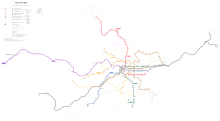
Several lines are planned to be added to the network.[88][89][90][91]
Wanda–Zhonghe–Shulin line
Wanda–Zhonghe–Shulin is a metro line under construction. The first section will run from CKS Memorial Hall to Juguang, Zhonghe, New Taipei. Another extension are still on planning stage.
Minsheng–Xizhi line
Minsheng–Xizhi is a planned metro line. As of February 2011, New Taipei has been pursuing the construction of the 17.52-km Minsheng–Xizhi line, though the most recent plan was rejected by the Ministry of Transportation and Communications, citing the need for further evidence for the line's viability.[92] The city plans to re-submit the proposal, and the project is estimated to cost NT$42.2 billion (US$1.44 billion).[92] A possible 4.25-km extension of the line to connect with the planned Keelung light rail is also being considered.[93] The line is planned to be built partially underground and partially elevated. It will begin from Dadaocheng Harbour beneath Minsheng West Road in Taipei, run along Minsheng East and West Roads, pass through Minsheng Community and journey under the Keelung River towards the Neihu District. The line will then change to an elevated mode and reach its termini at Xintai 5th Road in Xizhi District, New Taipei City. As of May 2018, the proposal for this line has been submitted to the Ministry Of Transportation and Communications, but has yet to be approved.[94]
Shezi, Shilin and Beitou light rail
An LRT system with two routes has been recommended for the Shezi, Shilin, and Beitou areas.
New Taipei Metro
Other lines are part of a separate New Taipei Metro network.
See also
- Maokong Gondola
- Taoyuan International Airport MRT
- Kaohsiung Mass Rapid Transit
- Rail transport in Taiwan
- Lists of rapid transit systems
- List of metro systems
Notes
-

- Two branch lines, sometimes grouped together with the main lines, are not counted separately
- [1] The number of stations is 131 if the 12 interchange stations (i.e. different sets of platforms) are counted multiple times, once for each line, while it's 119 if they're combined. Out-of-station transfers at Banqiao and Xinpu - Xinpu Minsheng, which require leaving paid area, are counted as 2 stations each; transfer stations that provide cross-platform interchange are anyway counted as a single stations.
- One train consists of four carriages on Wenhu line and six carriages on other lines.
- Wenhu line: 4; Xinbeitou and Xinbeitou branches: 3
- [2]
- Wenhu line
- Minimum 1:20
- Peak average 2:09
- Off-peak average 4:10
- Other lines
- Minimum 2:00
- Peak average 4:01
- Off-peak average 5:28
- Wenhu line
- Wenhu line: 1,880 mm (6 ft 2 in)
- Wenhu line: 33 metres (108 ft)
- Wenhu line: 32.84 kilometres per hour (20 mph)
- Wenhu line: 80 kilometres per hour (50 mph)
- Combined frequency
- Combined: 3 mins
- Combined: 4–5 mins
Words in native languages
-
- Chinese script: 臺北捷運
- Mandarin Pinyin: Táiběi jiéyùn
- Hokkien: Tâi-pak chia̍t-ūn
- Sixian Hakka: Thòi-pet chia̍p-yun
References
- "Network and Systems". Taipei Rapid Transit Corporation. 19 January 2020. Retrieved 22 January 2020.
- Taipei Rapid Transit Corporation. 2018 Annual Report (PDF) (Report). Retrieved 22 January 2020.
- "History". Department of Rapid Transit Systems, Taipei City Government. 1 August 2009. Retrieved 20 December 2017.
- "Metro Logo". Taipei Rapid Transit Corporation. 27 November 2009. Retrieved 20 December 2017.
- Lew, Alexander (15 October 2007). "Taipei Subway Ranks as one of the Best". Wired. Retrieved 13 March 2010.
- "Chronicles". Taipei Rapid Transit Corporation. 11 October 2010. Archived from the original on 17 November 2011. Retrieved 8 January 2011.
- 臺北市交通統計查詢系統. dotstat.taipei.gov.tw (in Chinese). Retrieved 15 September 2018.
- Voyer, Marc (30 June 2011). "The Best Public Transportation Systems In The World". Business Insider Australia. Retrieved 16 September 2018.
- "Can Singapore match Taipei's rail reliability?". The Straits Times. 9 June 2016. Retrieved 16 September 2018.
- "Traffic nightmares plague Taipei". The China Post. 20 September 2001. Retrieved 30 June 2010.
- 劉寶傑, 呂紹煒 (1994). 捷運白皮書:4444億的教訓-台北捷運 (in Chinese). 時報文化出版企業有限公司. ISBN 957-13-1432-3.
- 許昭琮, 張美華, 勞定華, 張束珍 (2000). 台北都會區捷運路網規劃理念 (in Chinese). 捷運技術. pp. 47–70.CS1 maint: multiple names: authors list (link)
- Her, Kelly (1 July 2001). "Sustainable Subways". Taiwan Review. Ministry of Foreign Affairs, Republic of China (Taiwan). Archived from the original on 11 March 2012. Retrieved 7 January 2011.
- Berlin Wu (10 May 1996). "Geotechnical Design and Construction Automation in Taiwan" (PDF). Massachusetts Institute of Technology. p. 33. Retrieved 7 January 2011.
- H. Ju; Z. C. Moh; R. N. Hwang (23 December 1998). "Soft Ground Tunneling for Taipei Rapid Transit Systems" (PDF). MAA Group. Retrieved 7 January 2011.
- "FEATURE: Halted gondola confirms worries". Taipei Times. 14 October 2008. Retrieved 6 August 2009.
- "Maokong Gondola reopens, featuring glass-bottomed car". The China Post. 31 March 2010. Retrieved 3 April 2010.
- "台北捷運內湖線大直段二十三日動工(大紀元時報)". 20 May 2002. Retrieved 2 September 2006.
- TsubasaTW (3 April 2008). "台北捷運廣播:善導寺站往台北車站(2008.02)". Youtube. Retrieved 13 September 2018.
- TsubasaTW (3 April 2008). "台北捷運廣播:古亭站往中正紀念堂站(2008.02)". Youtube. Retrieved 13 September 2018.
- TsubasaTW (3 April 2008). "台北捷運廣播:台大醫院站往台北車站(2008.02)". Youtube. Retrieved 13 September 2018.
- TsubasaTW (3 April 2008). "台北捷運廣播:忠孝新生站往忠孝復興站(2008.02)". Youtube. Retrieved 13 September 2018.
- "捷運環狀線 1月31日通車". 21 January 2020.
- "Metro Taipei Circular Line Driverless". Hitachi Rail. Retrieved 22 January 2020.
- "Free rides on MRT Circular Line to end Saturday - Focus Taiwan". focustaiwan.tw (in Chinese). Archived from the original on 3 March 2020. Retrieved 3 March 2020.
- News, Taiwan. "Map of new Taipei MRT Circular Line now up". Taiwan News. Retrieved 3 March 2020.
- "Metro Service: Danshui-Xindian Line". Taipei Rapid Transit Corporation. 16 October 2010. Archived from the original on 15 August 2011. Retrieved 4 July 2010.
- Mo Yan-chih (29 December 2010). "New Year's Eve revelers urged to use mass transit". Taipei Times. Retrieved 31 December 2010.
- "One train per 90 seconds on Neihu Line during peak hour: mayor". Taiwan News Online. 5 July 2009. Retrieved 16 August 2009.
- "Regulations for Use of the Taipei Metro System". Taipei Rapid Transit Corporation. 14 October 2009. Archived from the original on 17 November 2011. Retrieved 4 July 2010.
- "Taipei MRT moves English announcements to 2nd place". The China Post. 6 December 2015. Archived from the original on 6 March 2016. Retrieved 14 April 2016.
- Everington, Keoni (14 January 2020). "Taipei MRT to offer up to 30% monthly discoun..." Taiwan News.
- 車票種類、旅遊票推薦. 臺北大眾捷運股份有限公司 [Taipei Mass Rapid Transit Co., Ltd.].
- "Tickets". Taipei Metro. Retrieved 8 January 2018.
- "Facilities Inside the Station". Taipei Rapid Transit Corporation. 21 October 2009. Archived from the original on 15 August 2011. Retrieved 14 July 2010.
- "Facilities Outside the Station". Taipei Rapid Transit Corporation. 21 August 2008. Archived from the original on 15 August 2011. Retrieved 14 July 2010.
- "Trial Facilities". Taipei Rapid Transit Corporation. 30 December 2008. Archived from the original on 17 November 2011. Retrieved 14 July 2010.
- "Facilities for the Disabled". Taipei Rapid Transit Corporation. 30 December 2008. Archived from the original on 19 August 2011. Retrieved 14 July 2010.
- "台北地铁标识英译名年底前全部改为汉语拼音". news.sina.com.cn.
- "台鐵英譯亂象 年底清查正名 – 大紀元". 19 November 2009.
- 松山區公所網站管理員 (22 October 2004). "臺北市松山區公所". 臺北市松山區公所.
- "Taipei MRT to introduce new IC ticketing system". Taipei Times. 28 April 2007. Retrieved 1 July 2010.
- "Archived copy" 無線服務 (in Chinese). 臺北捷運公司. 14 July 2009. Archived from the original on 27 July 2011. Retrieved 7 January 2011.CS1 maint: archived copy as title (link)
- "World's first WiMAX-service MRT trains available in Taipei". Taiwan News. 3 June 2009. Retrieved 1 July 2010.
- "MRT offers mobile charging at six stations". Taipei Times. 3 March 2012. Retrieved 4 March 2012.
- "臺北捷運車站月臺門 全面建置完成". Taipei Metro (in Chinese). 28 September 2018. Retrieved 29 September 2018.
- "Archived copy". Archived from the original on April 28, 2010. Retrieved June 17, 2010.CS1 maint: archived copy as title (link) 防跳軌 捷運3站將設月台門- 自由電子報
- http://61.222.185.194/?FID=6&CID=47840 台灣新生報 | 防跳軌 北捷增3站設月台門
- "Taipei Rapid Transit Corporation '08 Annual Report" (PDF). Taipei Rapid Transit Corporation. Archived from the original (PDF) on 25 December 2011. Retrieved 1 May 2010.
- "MRT station suicide attempt fails". The China Post. 22 January 2008. Retrieved 1 July 2010.
- 蘇, 昭旭 (2017). 世界捷運與輕軌百科. Taiwan: 人人出版. ISBN 9789864610877.
- Fetsko, Michael E.; Drolet, Marc (2005). "An Overview of the Neihu Rapid Transit System: Taipei, Taiwan". Automated People Movers 2005. pp. 1–11. doi:10.1061/40766(174)62. ISBN 978-0-7844-0766-0.
- "August 2000". Erik's Rail News.
- OTIS Wang. "臺北捷運C381型高運量電聯車". 雪花台灣.
- "Taipei Circular line kicks off". Railway Gazette. 17 March 2009. Archived from the original on 10 March 2010. Retrieved 10 November 2019.
- "Department of Rapid Transit" (PDF). DORTS. Archived from the original (PDF) on 9 April 2008. Retrieved 13 November 2007.
- "FAQ: Affiliated Business". Taipei Rapid Transit Corporation. 7 July 2009. Archived from the original on 2 March 2012. Retrieved 14 July 2010.
- "East Metro Mall". TaipeiTravel.net. Archived from the original on 6 July 2010. Retrieved 14 July 2010.
- "2010 Annual Report" (PDF). Taipei Rapid Transit Corporation. Retrieved 4 March 2012.
- "Route Map". Taipei Rapid Transit Corporation. November 13, 2009. Archived from the original on January 21, 2010. Retrieved February 9, 2010.
- "The Wenhu Line closed down for 4 hours". Taiwan News Online. 6 August 2009. Retrieved 12 August 2009.
- Lin, Kuang-Chieh; Hsiao, Ying-Tung (April 2006). "Practical issues of system integration on the Taipei MRT System".
- "新店線小碧潭支線 第一列電聯車公開展示". Department of Rapid Transit Systems. 1 February 2006. Retrieved 18 June 2010.
- Originally 117/118, number change due to 2014 Taipei Metro attack
- "台北捷運車輛簡介". Travel Taiwan Rail. Retrieved 26 October 2019.
- "Completed MRT Routes". Retrieved 22 January 2020.
- "Circular Line Phase I Soon to Be Added to Taipei MRT Route Network to Provide the Public with More Comfortable and Convenient Transportation Services" (Press release). Taipei: Department of Rapid Transit Systems, Taipei City Government. 22 January 2020. Retrieved 22 January 2020.
- Department of Rapid Transit Systems, Taipei City Government (16 July 2019). "新莊線施工現況" [Current construction status of Xinzhuang Line] (in Chinese). Retrieved 22 January 2020.
- "Ridership Counts". Taipei Rapid Transit Corporation. 12 April 2016. Retrieved 14 April 2016.
- Mody, Ashoka (1997). Infrastructure strategies in East Asia: the untold story. World Bank Publications. p. 16. ISBN 0-8213-4027-1. Retrieved 10 January 2011.
- "Public transportation meeting opens in Taipei". Taiwan News Online. 11 March 2009. Retrieved 11 July 2010.
- 張家嘯 (26 November 2010). 蘆洲線試乘破305萬 橘色路線圖沒標錯. CardU 焦點新聞 (in Chinese). Retrieved 28 November 2010.
- "Luzhou Line property value rises through the roof". The China Post. 3 September 2010. Retrieved 6 September 2010.
- "Apartments near MRT stations see prices soar". The China Post. 18 February 2011. Retrieved 18 February 2011.
- "Taipei Metro Rating". Taipei Rapid Transit System. 22 November 2007. Archived from the original on 18 October 2007. Retrieved 22 November 2007.
- "Railway And transport strategy center (rtsc)". Imperial College London.
- "MRT ignores safety: councilors". Taipei Times. 20 February 2012. Retrieved 23 February 2012.
- 誕生與成長 (in Chinese). Taipei Rapid Transit Corporation. October 11, 2010. Archived from the original on July 27, 2011. Retrieved January 2, 2011.
- "Record breaking year for Taipei's MRT network". The China Post. 30 December 2010. Retrieved 31 December 2010.
- 跨年 北捷疏運250萬人次. CNA News (in Chinese). 1 January 2010. Retrieved 2 January 2010.
- "Taipei Metro Successfully Meets the Challenge of New Year's Eve Transport Service". Taipei Rapid Transit Corporation. 1 January 2011. Archived from the original on 2 March 2012. Retrieved 4 January 2011.
- "MRT ridership smashes record". Taipei Times. 2 January 2014. Retrieved 1 January 2014.
- hermesauto (30 May 2016). "Khaw Boon Wan urges Singapore train operators to emulate Taipei for reliability".
- "Taipei MRT shut down for a second day". Taipei Times. 18 September 2001.
- "Four killed, 21 wounded in Taipei subway knife attack". Taipei News.net. 21 May 2014. Archived from the original on 6 October 2014. Retrieved 2 August 2014.
- Huang, Sunrise; Wang, Hung-kuo; Holzer, Wesley (21 May 2014). "3 critically injured in stabbing on Taipei metro (update)". Focus Taiwan. Central News Agency (Republic of China). Retrieved 21 May 2014.
- "Four killed, 21 wounded in Taipei subway knife attack". The Straits Times. Agence France-Presse. 21 May 2014. Retrieved 21 May 2014.
- "Second Stage of Taipei MRT (Approved MRT Routes)". Department of Rapid Transit Systems, TCG. 12 March 2010. Archived from the original on 27 March 2012. Retrieved 21 April 2010.
- "臺北捷運 Taipei MRT" (PDF) (in Chinese). September 2010. p. 14. Archived from the original (PDF) on March 4, 2016. Retrieved October 4, 2010.
- 捷運白皮書 (in Chinese). Department of Rapid Transit Systems. December 23, 2010. Archived from the original on October 3, 2011. Retrieved January 8, 2011.
- "Third Stage of Taipei MRT (Planned MRT Routes)". Department of Rapid Transit Systems, TCG. 12 March 2010. Archived from the original on 15 August 2011. Retrieved 21 April 2010.
- "New Taipei City to re-examine proposed MRT". Taipei Times. 22 February 2011. Retrieved 21 February 2011.
- "Keelung Mayor Visits City Hall, Seeks Backing for MRT Line Extension". Taipei City Government. 5 January 2011. Retrieved 21 February 2011.
- "Planned MRT Routes".
External links
| Chinese Wikisource has original text related to this article: |
| Wikimedia Commons has media related to: |
- Taipei Future Rail Network Map
- Taipei Rapid Transit Corporation – official website
- Taipei Department of Rapid Transit Systems
- Taipei City Government – official website
- Taipei at UrbanRail.net

